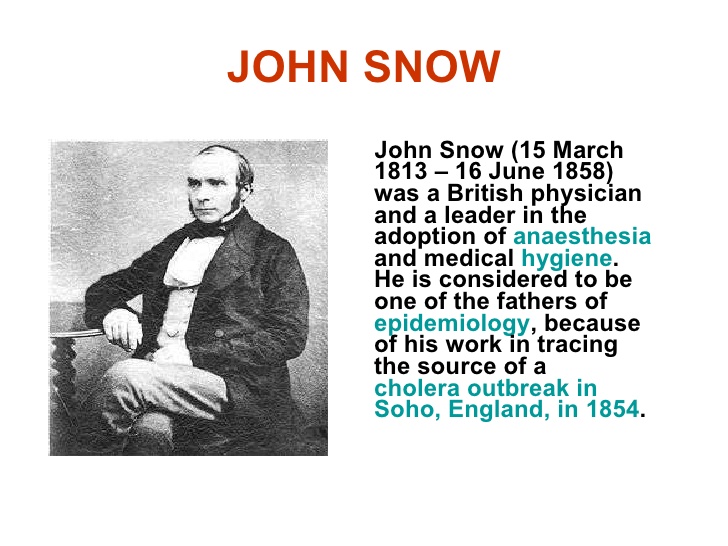Life
John Snow, born March 15th, 1813, in Yorkshire, was an English physician infamous for his research on the disease of cholera, whilst also widely recognized as the ‘father of contemporary epidemiology’. His most well-known research contain his examination of the ‘Broad Street pump’ epidemic that happened in London, in the year 1854, along with his “Grand Experiment,” which entailed a study, juxtaposing cholera afflictions in two parts of the city, the one receiving polluted water, whilst the other receiving clean one.
His inventive and ingenious reasoning and tactic to the control of this fatal disease remains valid and vital and may be considered as a model/guide for epidemiologists all over the world.
His status in anaesthesiology, especially pertaining to his familiarity with the chemicals of ether and chloroform, was enormous, so much so, that he was asked to administer chloroform to none other than Queen Victoria, in 1853, when she was giving birth, and also in 1857, to Princess Beatrice.
His accomplishments are held as truly extraordinary, even by standards of prodigies, accounting his humble origin, and upbringing, as well as short lifespan; wherein his demise was brought on by a stroke on June 16th, 1858, at the age of 45.
Education and Contributions to Anaesthesiology
Born and brought up in York, England, son of a coal yard worker, Snow’s early life was modest in terms of wealth and resources. He was the eldest child in a family of 11. When he was fourteen, in 1827, after school for a few years in York, he went to Yorkshire and obtained multiple medical internships there.
His earliest contact with the disease of Cholera was in the year 1831 when he went to visit some miners. This disease would, in time would go on to become the prime emphasis of his research. By the year 1836, Snow had started his official and full-fledged medical education, gaining a degree from the University of London, and becoming an official doctor of medicine in 1844.
In 1849, he went on to become a licensed specialist of the Royal College of Physicians, transcending to the top level in the realm of medicine. He resided, researched, and practised in the Soho locality.
In the year 1846, Snow came to know of the ability of ether to alleviate pain when performing medical practices, such as operations. He then gained mastery of its usage, later, in 1847, is stated on the position of an anaesthetist St. George’s Hospital. He then began to work with chloroform later that. And developed an apparatus to administer the same with remarkable efficiency, effectiveness, and safety precautions, as opposed to the one which was being utilized that time i.e. the “Drops in the Handkerchief” method.
His achievement in dosing chloroform to Queen Victoria gained a stark surge in the usage and affirmation of usage of gaseous anaesthesia. Snow talked broadly on his work with anaesthetics and went on to write his book On Chloroform and Other Anaesthetics, published in 1858, posthumously.
“Broad Street Pump” And The “Grand Experiment”
Numerous physicians of England engaged in the investigation of the epidemiology of the disease of Cholera. Snow was one of them. The 1st epidemic wave of Cholera happened in 1831–32, at the time when Snow was still but a student. During the 2nd wave, in 1848–49, he and others instituted the “London Epidemiological Society”, aiming to counsel the government on methods to battle the ailment. Snow came to a deduction that cholera had a causal link 
 to substances like microbes, agents having defining qualities of microbes, or germs, which proliferated through soiled clothing, polluted water, and direct faecal contact. This was in direct contrast with the theory dominant then, it being that cholera proliferated by miasma, or bad air, arising from decomposed organic substances. These two etiologic theories, the ‘germ theory’ and the ‘miasma theory’ underwent wide debates and deliberations, in light of the available medical and case-based evidence present, serving as the foundation for opinions for the two opposing views.
to substances like microbes, agents having defining qualities of microbes, or germs, which proliferated through soiled clothing, polluted water, and direct faecal contact. This was in direct contrast with the theory dominant then, it being that cholera proliferated by miasma, or bad air, arising from decomposed organic substances. These two etiologic theories, the ‘germ theory’ and the ‘miasma theory’ underwent wide debates and deliberations, in light of the available medical and case-based evidence present, serving as the foundation for opinions for the two opposing views.
Lasting for quite some time, the discussion was finally finished, when the organism, ‘Vibrio cholerae’ was well characterized in the 1880s, thus giving a win to the ‘germ theory’.
Snow’s esteemed status in the field of medicine, anaesthesiology, and epidemiology originated from the studies he underwent, pertaining to the third epidemic to attack England, which initiated in the year 1853 lasting till the year 1855.
The 1st study was in relation to the ‘Broad Street pump outbreak’ which happened in 1854, which caused the demise of myriads of people in Soho. Snow employed graphical representations, reasoning, and diagrams to show the effect of the polluted water which came from the’ Broad Street pump’ on health and life.
The 2nd study was the “Grand Experiment,” conducted in 1854 as well, which entailed a juxtaposition, and subsequent comparison of London neighbourhoods getting water from two distinct companies. One depended on inlets from the River Thames, situated away from society, whilst the other relied on inlets in the core/centre of London, where the contamination of water with sewage was prevalent and regular.
By his studies, Snow exhibited the damaging effect of contaminated water in two almost identical spheres of populations, and he recommended interventional methodologies in order to regulate the epidemic. His theories and notions, such as ‘innovative disease maps’, gained publication in his book “On the Mode of Communication of Cholera” of 1855. Snow’s work was republished in the 1930s, as an important work in epidemiology, consequentially giving his work long-term acknowledgement.